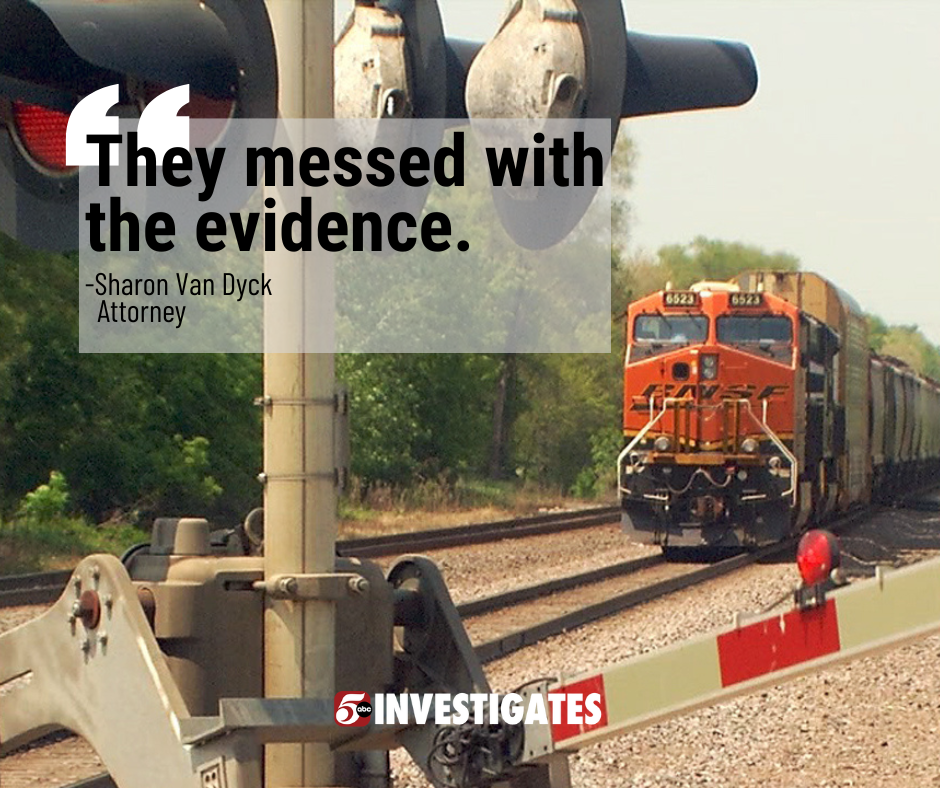Destroyed evidence and retaliation: The alarming pattern at Minnesota’s largest railroad
Sharon Van Dyck still keeps the color-coded legal files neatly categorized in the back of her garage in St. Louis Park.
After decades of practicing law, there is one case she cannot let go.
In September 2003, a freight train smashed into a car at a rail crossing in Anoka and instantly killed a group of four young friends.
“I get teary-eyed just thinking about it,” Van Dyck said during a recent interview. “For the families, it was awful. They were so strong.”
The tragedy led to a lengthy legal battle that ultimately exposed what a judge called a “staggering” amount of misconduct by the largest railroad in Minnesota.
“I never experienced anything like it,” said Van Dyck, one of the attorneys who represented the victims’ families in wrongful death lawsuits against Burlington Northern Santa Fe.
Twenty years later, BNSF has continued to engage in a pattern of misconduct after train accidents, according to a 5 INVESTIGATES analysis of court records
The railroad has repeatedly been sanctioned, fined and admonished by judges for destroying evidence, not complying with judicial orders, and retaliating against its own employees.
Legal and industry experts say the records offer troubling insight into a railroad company already under the microscope because of recent derailments in Minnesota.
“It’s a 20-year pattern, a 20-year pattern of concealment, 20-year pattern of deliberate corporate misconduct,” said Charles Reid, a law professor at the University of St. Thomas.
A BNSF spokesperson did not respond to multiple requests for an interview.
“They messed with the evidence”
From the beginning, BNSF insisted that the company was not at fault for the deaths of Brian Fraizer, Bridgette Shannon, Corey Chase and Harry Rhoades.
The company claimed the crossing arms and warning signals at the Ferry Street crossing in Anoka were functioning normally and accused the driver of trying to beat the train.
But holes emerged in their story as fast as key files disappeared.
“They messed with the evidence,” Van Dyck said.
A jury awarded the families $21 million after Van Dyck found the railroad altered a key piece of computer data involving the crossing arms.
BNSF engaged in “so many instances of misconduct” during the trial that the judge fined the company another $4 million.
“It now appears to all, including the jury, that BNSF either lost, altered, and/or destroyed the very evidence that it claims would prove definitely that the gates were functioning properly at the time of the accident,” Judge Ellen Maas wrote.
Pattern continues
After the trial in Anoka, a special report by the Star Tribune found BNSF had been sanctioned for misconduct in cases across the country.
“We have gotten better at preserving evidence,” an attorney for the company told the paper in 2010.
But 5 INVESTIGATES identified nearly 20 cases over the past decade that show the pattern of misconduct continued, including the destruction or withholding of evidence and retaliation against employees.
In 2014, a judge found BNSF “intimidated” and “maliciously” blamed a railroad conductor who was hurt during a crash in Montana.
“They’ve been fined, sanctioned, scolded, you name it,” said Alan Blackwell, a railroad consultant with more than 50 years of experience.

After another accident at a rail crossing in Minnesota, a judge criticized the railroad for providing “unacceptable excuses” when it was accused of destroying evidence.
“It’s the same thing,” Van Dyck said about the case in 2017. “Where’s this new system?”
In 2018, another judge in Minnesota fined the company $4.6 million for — again — destroying evidence, writing that it’s “clearly part of a pattern and practice of behavior nationwide.”
“You know, when a judge talks about a pattern of deception, a national pattern of deception, that is alarming,” said State Rep. Frank Hornstein, DFL-Minneapolis.
5 INVESTIGATES provided the list of cases to BNSF two weeks ago after it was requested by a company spokesperson.
One hour before the airing of this report, BNSF spokesperson Lena Kent sent a statement that said the company “disputes whether sanctions were appropriate even in the handful of cases cited” in this report.
The statement goes on to say BNSF is involved in numerous cases every year with no allegations of misconduct, which “is powerful evidence of BNSF’s good-faith efforts to collect, preserve, and disclose evidence in this, and every, case.”
Rail safety
Hornstein has been calling for more regulation of railroads for years. But his frustration with the industry intensified after 5 INVESTIGATES exposed a troubling history of defects on the same track where a BNSF train carrying ethanol derailed in March.
That derailment, which forced the town of Raymond to evacuate, is one of several rail incidents across the country that have led to a hyperfocus on rail safety.
After a Norfolk Southern train carrying toxic chemicals derailed in Ohio in February, congressional leaders demanded to know the safety record of the nation’s top railroad companies, including BNSF.
“The American people desperately need greater insight into an industry that lacks transparency and clear safety standards,” U.S. Senate Majority Leader Chuck Schumer, D-N.Y., wrote in a letter on March 15th.
The letter also asked about the safety culture at those companies.
When it comes to the largest railroad in Minnesota, Van Dyck said she already knows the answer.
“There’s a culture that they don’t do wrong. They can’t do wrong.”